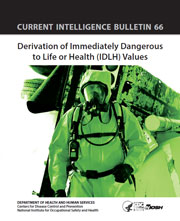Current Intelligence Bulletin 66: Derivation of Immediately Dangerous to Life or Health (IDLH) Values
November 2013
DHHS (NIOSH) Publication Number 2014-100

Since the establishment of the original Immediately Dangerous to Life or Health (IDLH) values in 1974, the National Institute for Occupational Safety and Health (NIOSH) has continued to review available scientific data to improve the methodology used to derive acute exposure guidelines, in addition to the chemical-specific IDLH values. The primary objective of this Current Intelligence Bulletin (CIB) is to present a methodology, based on the modern principles of risk assessment and toxicology, for the derivation of IDLH values, which characterize the health risks of occupational exposures to high concentrations of airborne contaminants. The methodology for deriving IDLH values presented in the CIB incorporates the approach established by the National Advisory Committee on Acute Exposure Guideline Levels (AEGLs) for Hazardous Substances—consisting of members from the U.S. Environmental Protection Agency, U.S. Department of Defense, U.S. Department of Energy, U.S. Department of Transportation, other federal and state government agencies, the chemical industry, academia, labor, and other organizations from the private sector—during the derivation of community-based acute exposure limits. The inclusion of the AEGL methodology has helped ensure that the IDLH values derived with use of the guidance provided in this document are based on validated scientific rationale.
The intent of this document is not only to update the IDLH methodology used by NIOSH to develop IDLH values based on contemporary risk assessment practices, but also to increase the transparency behind their derivation. The increased transparency will provide occupational health professionals, risk managers, and emergency response personnel additional information that can be applied to improve characterization of the hazards of high concentrations of airborne contaminants. This will also facilitate a more informed decision-making process for the selection of respirators and establishment of risk management plans for non-routine work practices and emergency preparedness plans capable of better protecting workers.
Current Intelligence Bulletin 66: Derivation of Immediately Dangerous to Life or Health (IDLH) Values [PDF – 2.34 MB]
